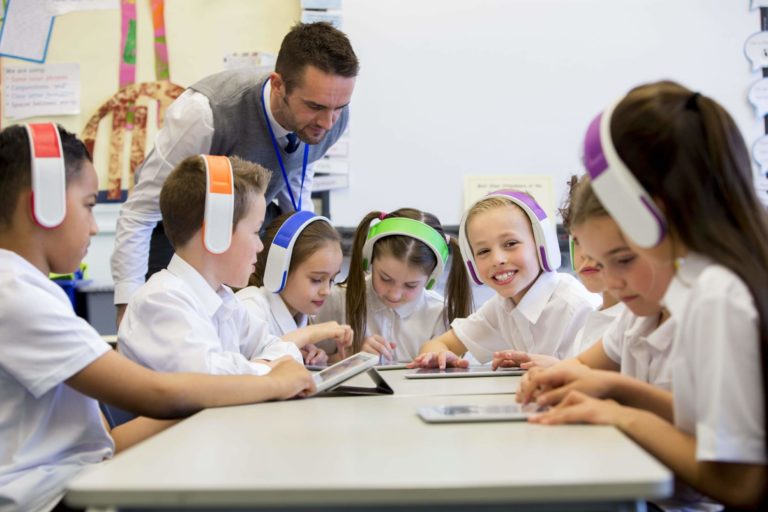When it comes to education, one size does not fit all. This holds true for everything from students’ reading levels to math skills and most certainly with technology. Because students have varying needs, teachers should take this into consideration when planning what technology tools they will use to support student learning. So why doesn’t one size fit all when it comes to technology, how do educators choose the right edtech tools for their students, and what are some great ones to consider?
Not All Students are the Same
Every student that walks into the classroom is unique. They bring different background experiences, different perspectives, and different interests. Not to mention they have different learning styles and different educational needs. That is why selecting one technology tool, app, or gadget does not work. In order to be a more effective teacher in the digital age, educators need to get to know their students to find out what they are interested in, how they like to learn, and what kinds of technology they have experience with.
Just as teachers give pretests to find out what students know about material before they start teaching, so too do educators need to figure out what types of technology students are familiar with. This helps with planning appropriate tools to use in the classroom to meet educational learning goals. Not all students are going to use the same tool to reach the learning objective. Some students will be able to show their learning in one way, and another student may take an entirely different approach. That is the beauty of technology; it gives teachers a gamut of tools to choose from to personalize learning. After all, true equity for students isn’t about everyone in the room having or using the same thing, but every student in the room having what it is they need to learn best.
How to Choose the Right EdTech Tools for Your Students
With over 100,000 apps labeled “education” in the app store, there are many things to consider when choosing the right edtech tools for students. The first is thinking about the learning outcome you want for your students and the means to get there. The SAMR model can be helpful for educators to use as a guide for how to best implement technology. Educators can ask themselves, “Is technology being used simply as a substitute for something else, or is it being used to modify or redefine learning?” If a technology tool redefines a traditional task in a way that would not have otherwise been possible, a student’s learning experience is transformed and enhanced. This is the ultimate goal of technology use and necessary to think about when implementing it.
The second thing to consider when using technology is social use. Because learning is socially constructed, it is important that teachers choose tools that allow students to engage together. Tools like Google Docs allow students to work together and collaborate on assignments. Prodigy is an interactive math game that uses gamification to engage students as they simultaneously work on answering math questions correctly. Students battle each other to earn badges and pets, creating a fun and competitive shared experience with classmates.
Lastly, the third thing to look for when choosing the right edtech tools for students is the possibilities for differentiation. Are teachers able to scaffold based on students’ learning levels or needs? Can teachers assign different content or program the tech tool to meet students at the level they are at? Apps like TeachMonster, Lalilo, or TweenTribune allow for teachers to adjust based on student needs. These are the types of apps that are easy to implement and effective to use for monitoring student progress.
Great EdTech Tools to Consider
The amount of edtech tools out there can make it overwhelming when teachers need to weed through them all for one that redefines learning, creates a socially constructed experience, and has the capability for differentiation. That is why it can feel relieving when teachers find one that fits just that.
EDpuzzle and Edij do all of these things. EDpuzzle is a website that allows teachers to find a video, add questions throughout it, and assign it to either individual students or the entire class. As the students watch the video, the clip has the abiliti to pause at various points so students will have to answer a question. This keeps students engaged and ensures that they watch the entirety of the clip. It also provides teachers with feedback on student understanding or allows students to pose a question they might have after watching.
Edij is another great edtech tool to consider. Edij is an application that provides a platform where students can read and analyze text, images, or PDFs. Students interact by highlighting text, adding tags, or commenting with audio clips or even emojis. Teachers can add open-ended questions to the activity that students answer. Additionally, there is a ‘Heat Vision’ that allows teachers to make all student comments visible to one another. Students can then respond to classmates’ comments or answer each other’s questions. This tool is interactive, collaborative, and engaging.
Conclusion
When it comes to educational technology tools, one size does not fit all. Teachers need to take this into consideration when planning appropriate tech tools to support student learning. Technology tools should redefine learning, be socially constructed, and have the capabilities of personalization in order to meet each individual student’s needs. This ensures that every student in the room has the tools they need for success.




